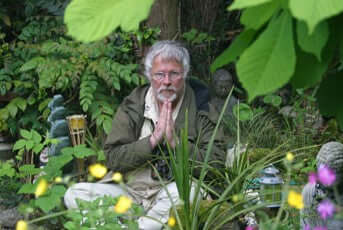
Wouldn’t it be ‘Cool’ to Create Britain’s Biggest Nature Reserve?
Share
I would honestly say that the most productive and the least threatened habitat in Britain are gardens. Every garden –no matter how small - has the potential to be a nature reserve. What’s more, add all those thousands of gardens together and it is a very big nature reserve.

I suppose we all think of wildlife as belonging in wild places! The woods, the moors, the marshes and of course what we refer to as the countryside. The fact is though that nearly all of what we call countryside is farmland, and as a result of intensive farming methods over the past fifty years or so, an awful lot of farmland has very little wildlife living on it. Insects, wildflowers and especially birds have all declined. That’s the bad news. The good news is that a lot of wildlife doesn’t have to be in the wild at all. An amazing amount thrives in gardens.
I would honestly say that the most productive and the least threatened habitat in Britain are gardens. Every garden –no matter how small - has the potential to be a nature reserve. What’s more, add all those thousands of gardens together and it is a very big nature reserve.
More good news is that it is very easy to attract birds to your garden. Plant and grow flowers, bushes and trees that provide what one might call natural food, and whilst you are waiting for the berries or seed heads to grow, put out specially developed bird foods. The ingredients are “natural” but they have been selected and blended as carefully as by any chef.
And there’s more:
There is one category of food that birds love to eat, and it is certainly natural. I am talking about worms, slugs, snails, caterpillars and the tiny aphids and bugs that may well be nibbling your carefully planted flowers and bushes. Gardeners hate them, but birds love them - which is why gardeners should welcome the birds.
Bird Feeding Guide:
1. Don't stop feeding the birds in summer as June and July are amongst the busiest months in the bird feeding calendar. Parent birds will be happy that you've provided food for them - so they can go in search for grubs and insects for their fledglings. Feeding soft food like Bill Oddie’s Premium Robin Crumble helps as, fledglings can eat the soft food.
2. If you want to feed the birds but don't want waste husks on the lawn/patio try a "husk free" bird food as all the seed husks have already been removed. (Bill Oddie's Premium Garden Friendly is such a recipe)
3. If you're putting up a nest box make sure it's not south facing as chicks can literally bake in the summer sun. There’s never a bad time to put up a nest box, but they’re more likely to be used from February onwards.
4. Clean, fresh water should always be made available. Better still add a small wildlife pond to the wildlife garden and be amazed how much more wildlife shows-up.
5. Feeding “Live foods” might sound grizzly to some people, but not to birds! However, for the squeamish, dried mealworms are a perfect solution as they still have good protein levels, and that’s why they’re in Bill Oddie’s Premium Robin Crumble
6. Peanuts can be fed all-year-round. But it’s considered best practice to feed them from a wire mesh peanut feeder, as birds - like Robins - could die if they tried to eat a whole peanut.
7. Feeding the birds is great fun and helping nature is a pleasure. However, some wild bird foods do leave waste husks beneath feeding stations - an example of such a bird food would be black sunflower – and these husks need to be cleared up regularly to keep bird feeding stations clean and bird friendly. If you find this a problem, then choose Bill’s Premium Garden Friendly instead as there’ll be hardly any waste at all to clean away.
8. When a large number of birds are attracted into your garden to feed, their chances of contracting a disease are slightly increased because they’re coming together in one place and in numbers, which they might not do in the wild. However, there’s nothing to worry about at all, provided you keep tables and feeders clean. You should also move feeders and tables to different positions within the garden to prevent the ground below them getting infected.
9. Positioning of feeders and bird tables: Bird feeders can be hung from trees, fence posts, or from special poles. It can take a week, or so, for birds to get used to a new bird feeder – but they generally will! Tables are fine on the lawn or a patio. Again, move feeders and tables regularly to avoid creating areas susceptible to bacteria.

Written by Simon H. King

